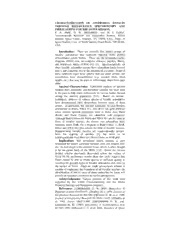
NASA Technical Reports Server (NTRS) 20060020741: Characterization of Asteroidal Basalts through Reflectance Spectroscopy and Implications for the Dawn Mission PDF
Preview NASA Technical Reports Server (NTRS) 20060020741: Characterization of Asteroidal Basalts through Reflectance Spectroscopy and Implications for the Dawn Mission
CHARACTERIZATION OF ASTEROIDAL BASALTS THROUGH REFLECTANCE SPECTROSCOPY AND IMPLICATIONS FOR THE DAWN MISSION. P. A. Abell1, D. W. Mittlefehdlt1, and M. J. Gaffey2. 1Astromaterials Research and Exploration Science, NASA Johnson Space Center, Houston, TX 77058, USA. 2Dept. of Space Studies, Univ. of North Dakota, Grand Forks, ND 58202, USA. Introduction: There are currently five known groups of basaltic achondrites that represent material from distinct differentiated parent bodies. These are the howardite-eucrite- diogenite (HED) clan, mesosiderite silicates, angrites, Ibitira, and Northwest Africa (NWA) 011 [1]. Spectroscopically all these basaltic achondrite groups have absorption bands located near 1 and 2 microns due to the presence of pyroxene. Some of these meteorite types have spectra that are quite similar, but nevertheless have characteristics (e.g. spectral slope, band depths, etc.) that may be used to differentiate them from each other. Spectral Characteristics: Laboratory analysis of spectral features from meteorites and terrestrial samples has been used in the past to help make connections to various bodies located among the asteroid population [2-4]. Based on similar techniques, analyses of various spectra of basaltic achondrites have demonstrated clear distinctions between some of these groups. In particular, the spectral signatures of such basaltic achondrites as Ibitira, NWA 011, and HEDs are quite different when various spectral parameters such as Band Area Ratio (BAR) and Band Centres are identified and compared. Although Band Centres for Ibitira and NWA 011 are the same as those of basaltic eucrites, the former two achondrites have distinctly lower BAR. On a diagram of Band Centre vs. BAR, Ibitira and NWA 011 plot outside the field of basaltic eucrites. Stannern-trend basaltic eucrites are compositionally distinct from the majority of eucrites [5], but seem to be indistinguishable from them on a Band Centre vs. BAR plot. Implications: The revitalized Dawn mission is now scheduled for launch sometime between June and August 2007 [6]. Its first target is the asteroid Vesta, which is often thought to be the parent body of the HEDs [7,8]. Given the various distinct terrains previously discovered across the surface of Vesta [9,10], preliminary results from this study suggest that Dawn should be able to obtain spectra of sufficient quality to constrain the possible types of basaltic achondrites that exist on the surface of Vesta. Since no single petrogenesis scheme is capable of explaining the formation of all basaltic eucrites, the identification of one or more of these meteorites on Vesta will provide an important constraint on eucrite petrogenesis. Acknowledgments: Various portions of this work were supported by the NASA Cosmochemistry and the NASA Planetary Geology and Geophysics programs. References: [1]Mittlefehldt D. W. 2005. Meteoritics & Planetary Science 40:655-677. [2]Gaffey M. J. 1976. Journal of Geophysical Research 81:905-920. [3]Cloutis E. M. et al. 1986 Journal of Geophysical Research 91:11641-11653. [4]Gaffey et al. 1993. Icarus 106:573-602. [5]Mittlefehldt D. W. and Lindstrom M. M. (2003) Geochimica et Cosmochimica Acta 67:1911-1935. [6]Russell C. T. et al. 2004. Planetary & Space Science 52:465-489. [7]McCord T. B. et al. 1970. Science 168:1445-1447. [8]Drake M. J. 2001. Meteoritics & Planetary Science 36:501-513. [9]Gaffey M. J. 1997. Icarus 127:130-157. [10]Binzel R. P. 1997. Icarus 128:95-103.
